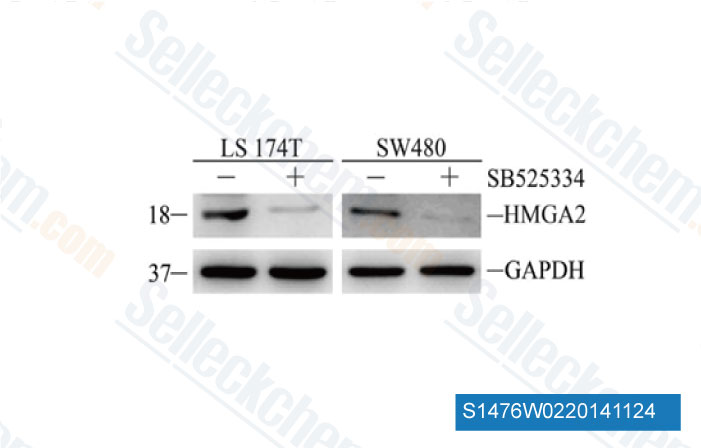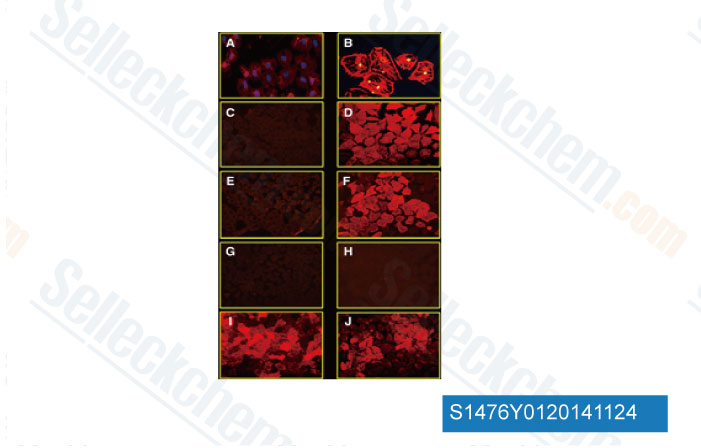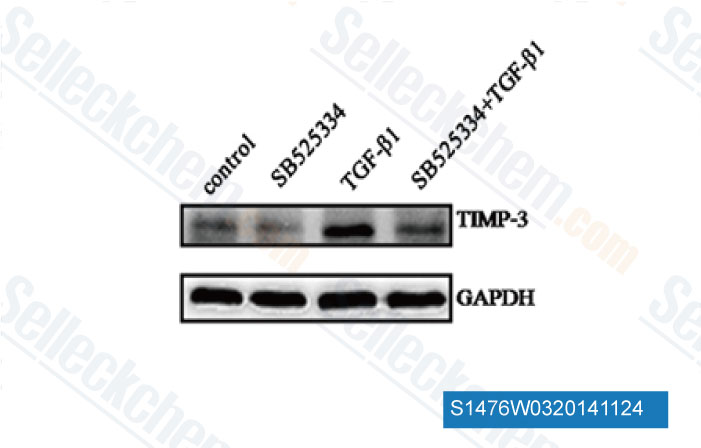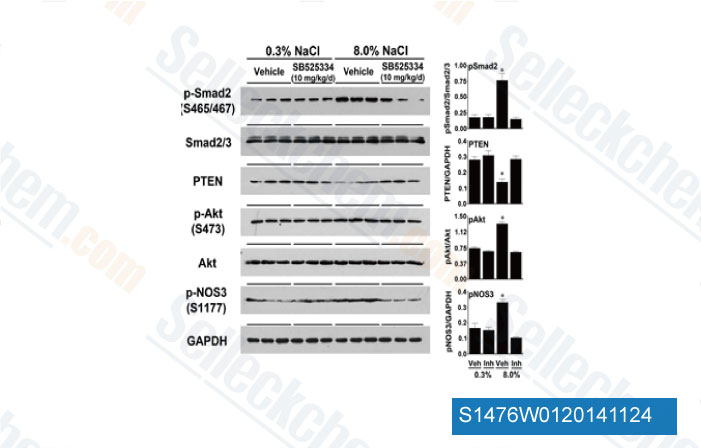|
Toll Free: (877) 796-6397 -- USA and Canada only -- |
Fax: +1-832-582-8590 Orders: +1-832-582-8158 |
Tech Support: +1-832-582-8158 Ext:3 Please provide your Order Number in the email. |
Technical Data
| Formula | C21H21N5 |
|||
| Molecular Weight | 343.42 | CAS No. | 356559-20-1 | |
| Solubility (25°C)* | In vitro | DMSO | 68 mg/mL (198.0 mM) | |
| Ethanol | 68 mg/mL (198.0 mM) | |||
| Water | Insoluble | |||
|
* <1 mg/ml means slightly soluble or insoluble. * Please note that Selleck tests the solubility of all compounds in-house, and the actual solubility may differ slightly from published values. This is normal and is due to slight batch-to-batch variations. * Room temperature shipping (Stability testing shows this product can be shipped without any cooling measures.) |
||||
Preparing Stock Solutions
Biological Activity
| Description | SB525334 is a potent and selective inhibitor of TGFβ receptor I (ALK5) with IC50 of 14.3 nM in a cell-free assay, 4-fold less potent to ALK4 than ALK5 and inactive to ALK2, 3, and 6. | ||
|---|---|---|---|
| Targets |
|
||
| In vitro | SB 525334 shows no inhibition in the enzymes ALK2, 3, and 6, with IC50 values > 10 μM. SB 525334 blocks phosphorylation induced by TGF-β1 and nuclear translocation of Smad2/3 in renal proximal tubule cells. SB 525334 also inhibits the increased mRNA expression levels of plasminogen activator inhibitor-1 (PAI-1) and procollagen α1(I) induced by TGF-β1 in A498 renal epithelial carcinoma cells at 1 μM). [1] SB 525334 (1 μM) attenuates the heightened sensitivity to TGF-β1 exhibited by pulmonary artery smooth muscle cells (PASMCs) from patients with familial forms of idiopathic pulmonary arterial hypertension (PAH). [2] | ||
| In vivo | SB 525334 (10 mg/kg/day) decreases the renal mRNA levels of PAI-1, procollagen α1(I), and procollagen α1(III) in a nephritis-induced renal fibrosis rat model. Furthermore, PAN-induced proteinuria is significantly inhibited by SB 525334 (10 mg/kg/day). [1] SB 525334 may also be efficacious in mesenchymal tumors. SB 525334 (10 mg/kg/day) significantly decreases uterine mesenchymal tumor incidence, multiplicity, and size in Eker rats. [3] SB 525334 significantly reverses pulmonary arterial pressure and inhibits right ventricular hypertrophy in a rat model of PAH. This is revealed by a significant reduction in pulmonary arteriole muscularization induced by monocrotaline (used to induce PAH) after treatment with SB 525334 (3 or 30 mg/kg). [2] In a Bleomycin-induced pulmonary fibrosis mice model, SB 525334 (10 mg/kg or 30 mg/kg) attenuates the histopathological alterations in the lung, and significantly decreased mRNA expression of Type I and III procollagen and fibronectin. SB 525334 also attenuates Smad2/3 nuclear translocation, myofibroblast proliferation, deposition of Type I collagen, and decreases CTGF-expressing cells. [4] |
Protocol (from reference)
| Kinase Assay:[1] |
|
|---|---|
| Cell Assay:[1] |
|
| Animal Study:[3] |
|
References
Customer Product Validation

-
Data from [Data independently produced by Cancer Lett, 2014, 355(1), 130-40]

-
Data from [Data independently produced by Cell Signal, 2014, 10.1016/j.cellsig.2014.09.010]

-
Data from [Data independently produced by Cell Signal, 2014, 10.1016/j.cellsig.2014.09.010]

-
Data from [Data independently produced by Hypertension, 2013, 62(5), 951-6]
Selleck's SB525334 has been cited by 98 publications
| ESRRB Inhibits the TGFβ Signaling Pathway to Drive Cell Proliferation in Cervical Cancer [ Cancer Res, 2023, 83(18):3095-3114] | PubMed: 37350664 |
| Identification of fibrocyte cluster in tumors reveals the role in antitumor immunity by PD-L1 blockade [ Cell Rep, 2023, 42(3):112162] | PubMed: 36870329 |
| Impact of retrotransposon protein L1 ORF1p expression on oncogenic pathways in hepatocellular carcinoma: the role of cytoplasmic PIN1 upregulation [ Br J Cancer, 2023, none] | PubMed: 36707636 |
| Trichinella spiralis-Secreted Products Promote Collagen Capsule Formation through TGF-β1/Smad3 Pathway [ Int J Mol Sci, 2023, 24(19)15003] | PubMed: 37834451 |
| Glioma-derived small extracellular vesicles induce pericyte-phenotype transition of glioma stem cells under hypoxic conditions [ Cell Signal, 2023, 109:110754] | PubMed: 37315748 |
| Targeting fibrotic signaling pathways by EGCG as a therapeutic strategy for uterine fibroids [ Sci Rep, 2023, 13(1):8492] | PubMed: 37231028 |
| Mechanical force regulates Sox9 expression at the developing enthesis [ Development, 2023, 150(16)dev201141] | PubMed: 37497608 |
| The mast cell exosome-fibroblast connection: A novel pro-fibrotic pathway [ Front Med (Lausanne), 2023, 10:1139397] | PubMed: 36910476 |
| BMAL1 Promotes Valvular Interstitial Cells' Osteogenic Differentiation through NF-κ B/AKT/MAPK Pathway [ J Cardiovasc Dev Dis, 2023, 10(3)110] | PubMed: 36975874 |
| TGFB1 Induces Fetal Reprogramming and Enhances Intestinal Regeneration [ bioRxiv, 2023, 2023.01.13.523825] | PubMed: 36711781 |
RETURN POLICY
Selleck Chemical’s Unconditional Return Policy ensures a smooth online shopping experience for our customers. If you are in any way unsatisfied with your purchase, you may return any item(s) within 7 days of receiving it. In the event of product quality issues, either protocol related or product related problems, you may return any item(s) within 365 days from the original purchase date. Please follow the instructions below when returning products.
SHIPPING AND STORAGE
Selleck products are transported at room temperature. If you receive the product at room temperature, please rest assured, the Selleck Quality Inspection Department has conducted experiments to verify that the normal temperature placement of one month will not affect the biological activity of powder products. After collecting, please store the product according to the requirements described in the datasheet. Most Selleck products are stable under the recommended conditions.
NOT FOR HUMAN, VETERINARY DIAGNOSTIC OR THERAPEUTIC USE.
